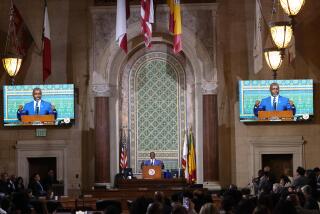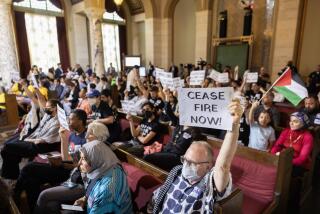Protest Rally by Disabled
- Share via
We are appreciative of Kevin Roderick’s excellent coverage of our protest of Mayor Tom Bradley’s discriminatory policies toward people with disabilities (“Group of Disabled Assail Bradley; 6 Quit as Advisers,” Metro, April 22), but we would like to correct several statements made by Deputy Mayor Mike Gage that were included in the article as well as furnish your readers with some additional information.
Gage suggests that the six resignations were a small portion of the 45-member council. In fact, on the day of our resignations, there were only 31 members on the advisory council, four of whom had been appointed by the mayor only 10 days previously. The latest available membership list, distributed by the deputy director of the mayor’s Office for the Disabled at the April 11 council meeting, lists a total of 15 mayoral appointees, of whom 8 are nondisabled, 5 are disabled, and 2 are not designated as either; 8 appointees by members of the City Council, all of whom are persons with disabilities; and 8 organizational members elected by the advisory council itself, of whom 7 are disabled. In addition, two other persons with disabilities, William Jordan and Hugh Hallenberg, have resigned from the advisory council in recent months, over the same issues. Those 25 persons remaining on the advisory council include 14 appointed by the mayor, of whom 50% are nondisabled.
The Los Angeles Coalition for Disability Rights, which sponsored the protest rally, includes a broad range of organizations and individuals, and represents many different disabilities and sensory impairments, and large numbers of people within the city. There were, in fact, more than 35 disabled persons at the protest rally, though a smaller number went inside to the mayor’s office.
It is hard to believe that the mayor was planning to establish a city Commission on Disability long before our protest, when only last November, Bill Elkins, his special assistant, told us “you are not ready” for commission status. And the mayor can hardly take credit for the Handicapped Access Commission, which is required by California law, and was created only after the city was pressured to comply by William Jordan and several other persons with disabilities.
We too used to be proud to say that Bradley had established the first mayoral Office for the Disabled. But time and events moved forward and the mayor and his office have not moved with them.
The mayor’s Office for the Disabled cannot be a source of pride as long as it continues to be headed by a nondisabled person, and as long as it competes with community-based agencies for training funds, rather than serving as an advocate for persons with disabilities.
As for access ramps, that is almost a joke, albeit a sad one. The Bureau of Street Maintenance has reported to us that there have been no funds allocated to this purpose for several years. We suggest Gage join us one day as we attempt to get around the city in our wheelchairs! Getting stuck in the middle of a street corner where there are ramps on only one side is really not funny at all.
Gage has said, “This is not . . . a tidal wave.” We advise him to wait and see.
NADIA POWERS
JANE SMALL
Los Angeles
(The writers are former members of the L.A. City Advisory Council on Disability and founding members of the L.A. Coalition for Disability Rights.)
More to Read
Sign up for Essential California
The most important California stories and recommendations in your inbox every morning.
You may occasionally receive promotional content from the Los Angeles Times.










